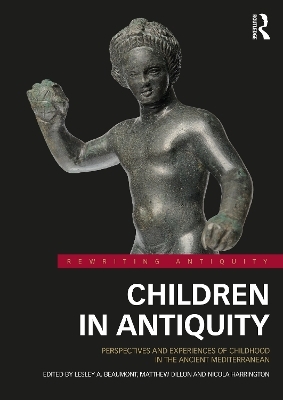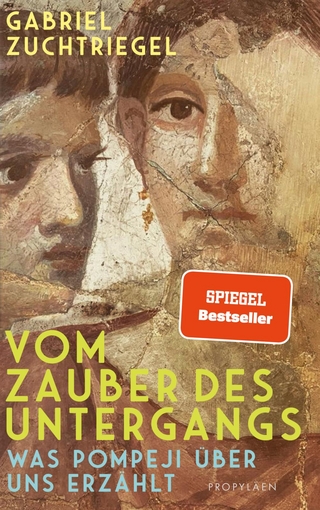
Children in Antiquity
Routledge (Verlag)
978-0-367-61999-2 (ISBN)
This collection employs a multi-disciplinary approach treating ancient childhood in a holistic manner according to diachronic, regional and thematic perspectives. This multi-disciplinary approach encompasses classical studies, Egyptology, ancient history and the broad spectrum of archaeology, including iconography and bioarchaeology.
With a chronological range of the Bronze Age to Byzantium and regional coverage of Egypt, Greece, and Italy this is the largest survey of childhood yet undertaken for the ancient world. Within this chronological and regional framework both the social construction of childhood and the child’s life experience are explored through the key topics of the definition of childhood, daily life, religion and ritual, death, and the information provided by bioarchaeology. No other volume to date provides such a comprehensive, systematic and cross-cultural study of childhood in the ancient Mediterranean world. In particular, its focus on the identification of society-specific definitions of childhood and the incorporation of the bioarchaeological perspective makes this work a unique and innovative study.
Children in Antiquity provides an invaluable and unrivalled resource for anyone working on all aspects of the lives and deaths of children in the ancient Mediterranean world.
Lesley A. Beaumont is Associate Professor of Classical Archaeology at the University of Sydney. Her many publications on children in classical antiquity include Childhood in Ancient Athens: Iconography and Social History (Routledge 2012). She co-organised the 2015 international conference on "Children in Antiquity" at the University of Sydney and co-curated the accompanying Nicholson Museum exhibition. Matthew Dillon is Professor of Classics and Ancient History at the University of New England, Armidale, Australia. He has written extensively on Greek religion and society. Nicola Harrington is an Egyptologist and Honorary Research Associate of the University of Sydney. She received her DPhil from the University of Oxford, and her doctoral thesis formed the basis of the monograph Living with the Dead: Ancestor Worship and Mortuary Cult in Ancient Egypt (2012). Her research interests include religion, childhood, and mental illness in antiquity.
Introduction: investigating the ancient Mediterranean ‘childscape’ PART I: What is a child? 1. The ancient Egyptian conception of children and childhood 2. What is a child in Aegean prehistory? 3. Ideological constructions of childhood in Bronze and Early Iron Age Italy: personhood between marginality and social inclusion 4. Defi ning childhood and youth: a regional approach to Archaic and Classical Greece: the case of Athens and Sparta 5. The child in Etruscan Italy 6. Children and the Hellenistic period 7. Roman childhood revisited 8. From birth to rebirth: perceptions of childhood in Greco-Roman Egypt 9. Looking for children in Late Antiquity 10. From village to monastery: fi nding children in the Coptic record from Egypt PART II: Daily life 11. The child’s experience of daily life in ancient Egypt 12. Changing states: daily life of children in Mycenaean and Early Iron Age Greece 13. Children in early Rome and Latium 14. Being a child in Archaic and Classical Greece 15. The daily life of Etruscan babies and children 16. Being a child in the Hellenistic world: a subject out of proportion? 17. Different lives: children’s daily experiences in the Roman world 18. Children as instruments of policy in Hadrian’s Egypt 19. Daily life of children in Late Antiquity: play, work and vulnerability PART III: Religion and ritual 20. “Child in the nest”: children in Pharaonic Egyptian religion and rituals 21. Children and Aegean Bronze Age religion 22. Initiating children into Italian Bronze and Early Iron Age ritual, religion and cosmology 23. Children in Archaic and Classical Greek religion: active and passive ritual agency 24. Children in Etruscan religion and ritual 25. Children’s roles in Hellenistic religion 26. Children in Roman religion and ritual 27. Children, religion and ritual in Greco-Roman Egypt 28. The child in Late Antique religion and ritual PART IV: Death 29. Child, infant and foetal burials in the Egyptian archaeological record: exploring cultural capacities from the Predynastic to Middle Kingdom Periods (c. 4400–1650 BC) 30. “Do not say ‘I am young to be taken’ ”: children and death in ancient Egypt: Second Intermediate Period to the Late Period 31. Children and death in Bronze Age and Early Iron Age Greece 32. Children, death and society in Late Bronze Age and Iron Age Sicily 33. Children and death in Archaic and Classical Greece 34. Infancy and childhood in funerary contexts of Early Iron Age Middle Tyrrhenian Italy: a comparative approach 35. Child death in the Hellenistic world 36. Death of a Roman child 37. Death of a child: demographic and preparation trends of juvenile burials in the Graeco-Roman Fayoum 38. Infant mortality, Michael Psellos and the Byzantine demon Gillo PART V: Bioarchaeology 39. The bioarchaeology of children in Greco-Roman antiquity 40. Infancy and childhood in Roman Egypt: bioarchaeological perspectives 41. “The greatest of treasures”: advances in the bioarchaeology of Byzantine children
| Erscheinungsdatum | 31.01.2024 |
|---|---|
| Reihe/Serie | Rewriting Antiquity |
| Zusatzinfo | 16 Tables, black and white; 10 Line drawings, black and white; 88 Halftones, black and white; 98 Illustrations, black and white |
| Verlagsort | London |
| Sprache | englisch |
| Maße | 174 x 246 mm |
| Gewicht | 1360 g |
| Themenwelt | Geisteswissenschaften ► Archäologie |
| Geschichte ► Allgemeine Geschichte ► Vor- und Frühgeschichte | |
| Geschichte ► Allgemeine Geschichte ► Altertum / Antike | |
| Sozialwissenschaften ► Soziologie | |
| ISBN-10 | 0-367-61999-7 / 0367619997 |
| ISBN-13 | 978-0-367-61999-2 / 9780367619992 |
| Zustand | Neuware |
| Informationen gemäß Produktsicherheitsverordnung (GPSR) | |
| Haben Sie eine Frage zum Produkt? |
aus dem Bereich


